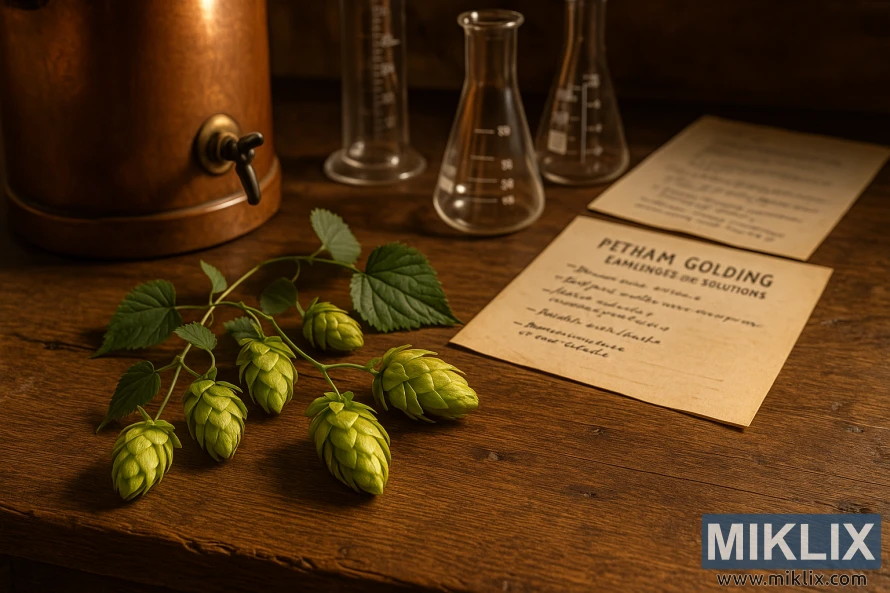Image: Brewing with Petham Golding Hops
Published: August 10, 2025 at 11:12:34 AM UTC
Last updated: September 27, 2025 at 8:51:52 AM UTC
Fresh Petham Golding hops rest on a rustic table with a copper kettle, glass beakers, and brewing notes, highlighting their role in craft beer brewing.
Spread across a time-worn wooden table, the elements of brewing converge into a scene that feels both rustic and scholarly, as though caught between the worlds of tradition and experimentation. A small copper brew kettle sits at one edge, its polished surface glowing warmly under the soft light, a spout jutting forward like a sentinel of countless brews past. Nearby, an assortment of glass beakers and flasks stand empty but expectant, their clean, sharp lines contrasting with the organic irregularity of the hops laid before them. These vessels suggest analysis and precision, hinting at the laboratory side of brewing where recipes are tested, variables are measured, and refinements are made in pursuit of consistency and excellence. The glassware and kettle together represent the partnership of science and craft, a balance at the heart of every successful beer.
The focal point lies in the fresh Petham Golding hops spread across the foreground. Still attached to a small vine, the cones appear plump and vibrant, their overlapping bracts forming the iconic pinecone-like shapes that brewers and drinkers alike associate with character and aroma. Their hues shift subtly from light lime green at the tips to deeper emerald tones at the base, a reminder of their freshness and vitality. A pair of broad leaves attached to the stem adds to the visual balance, anchoring the cones in their natural context, reminding us that these fragrant flowers were harvested from living bines that once climbed high in neat rows across the countryside. Their delicate forms cast faint shadows on the table, patterns that seem to echo the complexity hidden within—the resins and oils that will soon give structure and personality to a brew.
Scattered across the wooden surface are handwritten notes, pages that appear weathered yet essential. One sheet is clearly marked with the heading “Petham Golding,” followed by a list of observations and brewing solutions, suggesting that this moment captures not just admiration for the hops but active problem-solving in their use. Perhaps the brewer is refining a recipe, troubleshooting bitterness levels, or exploring how this variety’s gentle, floral earthiness can balance against different malt bills. The presence of these notes highlights the thoughtful and iterative nature of brewing: it is not merely a mechanical process, but an evolving dialogue between ingredients, equipment, and brewer. The written word here serves as both a guide and a record, tying the present moment to future batches and past experiments.
The lighting imbues the entire scene with warmth and intimacy. Soft, amber tones illuminate the copper and wood, wrapping the setting in a contemplative mood that feels as much about reflection as action. This is not a hurried workspace but one where time slows, where the brewer might pause to consider the qualities of the hops, the readings of the instruments, and the wisdom contained in the notes before moving forward. The elevated angle of the composition allows the viewer to take in the interconnected elements—the hops, the equipment, the notes—as though witnessing a snapshot of the brewing mind at work. It is a reminder that every glass of beer begins with moments like this: the quiet study of ingredients, the careful blending of art and science, and the patient pursuit of harmony between them.
Here, the Petham Golding variety takes center stage, not in a pint glass but in its raw and fragile form, embodying both promise and challenge. Known for its subtle aroma of spice, earth, and delicate floral tones, it is a hop that requires sensitivity to use well, rewarding the attentive brewer with balance and elegance rather than overwhelming force. The photograph captures that essence: the stillness before transformation, the intimacy of creation, and the reverence for a plant that has shaped brewing for centuries. It is both a portrait of hops and a meditation on the craft itself, where every detail matters and every decision carries forward into the taste of a shared drink.
The image is related to: Hops in Beer Brewing: Petham Golding

